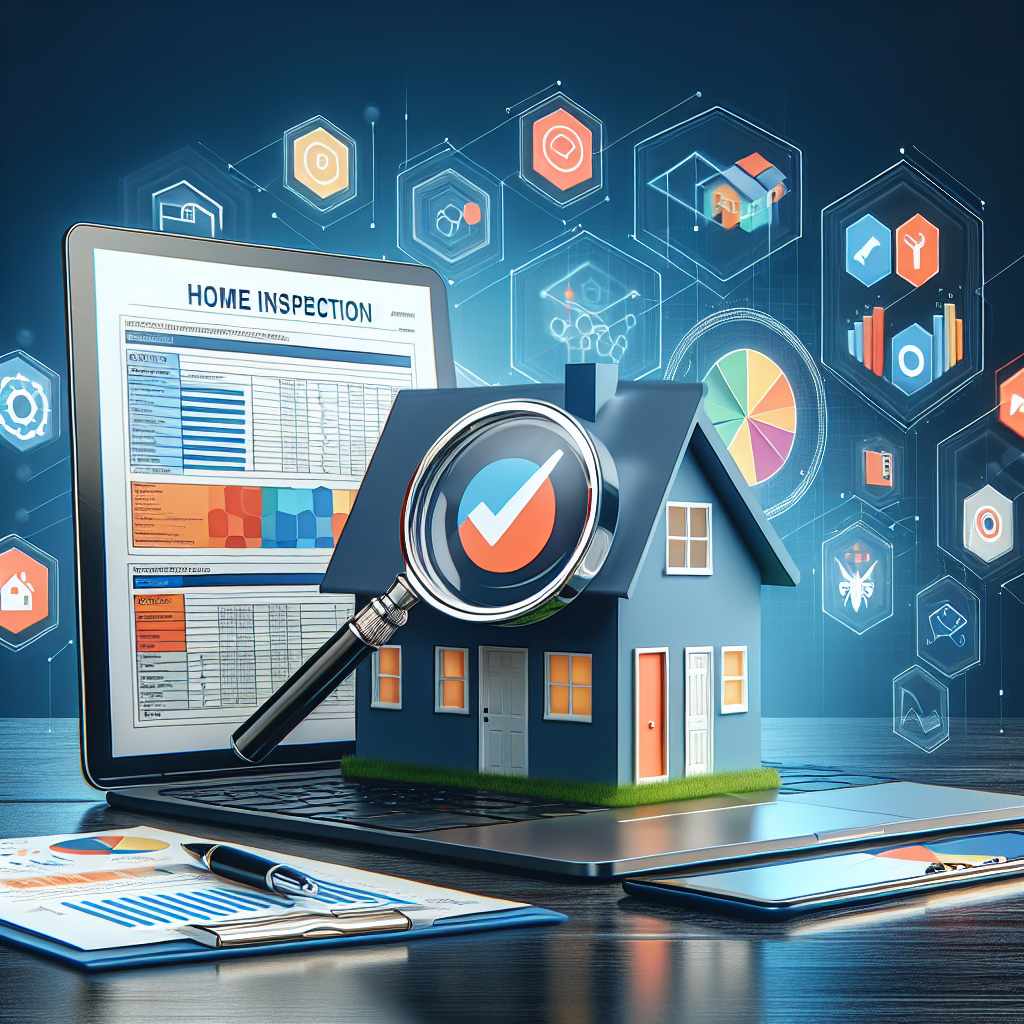Home inspection is a critical process that enables homeowners, buyers, and real estate agents to evaluate the condition of a property. Traditionally, home inspectors would manually create lengthy reports detailing their findings. However, with the advent of technology and specifically home inspection software, generating professional PDF reports has become much more efficient.

Home inspection software offers a comprehensive solution that simplifies the entire reporting process. It provides inspectors with pre-built templates that are designed to cover all essential aspects of a thorough inspection. These templates can be customized according to specific requirements or regulations in different regions.
By utilizing home inspection software, inspectors can easily input their observations and findings directly into the system during an on-site assessment. This eliminates the need for tedious manual note-taking and later transcribing those notes into written reports.
The software also allows for seamless integration of photos taken during the inspection into the final report. Inspectors can simply upload images directly from their devices or cameras and place them within relevant sections of the report template.
Furthermore, home inspection software often includes features such as automatic calculations, which streamline complex calculations related to areas like square footage or energy efficiency ratings. This ensures accurate results without any manual errors or miscalculations.
Once all data has been entered and necessary photographs added, inspectors can generate professional PDF reports at just a click of a button. These reports are automatically compiled using the information provided by the inspector throughout the assessment process.
The generated PDF reports appear polished and highly professional while being informative and easy-to-understand for clients who may not have extensive knowledge about construction or building systems. The standardized format ensures consistency across all inspections conducted by an individual inspector or company.
In conclusion, home inspection software greatly enhances efficiency when it comes to generating professional PDF reports. By eliminating manual note-taking tasks and streamlining various aspects of report creation such as photo integration and calculations, this technology allows home inspectors to focus more on the actual inspection process while delivering high-quality reports to their clients.
The Importance of Professional PDF Reports in Home Inspections
In the field of home inspections, generating professional reports is of utmost importance. These reports provide a comprehensive overview of the condition of a property, highlighting any potential issues or areas that require attention. With advancements in technology, home inspection software has emerged as a valuable tool for efficiently producing these reports. This article aims to emphasize the significance of professional PDF reports in home inspections and demonstrate how utilizing dedicated software can streamline the process.
First and foremost, professional PDF reports serve as an official documentation of the findings during a home inspection. They provide a detailed record that outlines all aspects examined by the inspector – from structural integrity to electrical systems and everything in between. By presenting this information in a standardized format, these reports enable homeowners, buyers, and real estate agents to make informed decisions about properties.

Moreover, professional PDF reports are essential for legal purposes. In many jurisdictions, such documents are required during property transactions or insurance claims processes. The accuracy and professionalism demonstrated within these reports contribute to building trust between all parties involved while minimizing potential disputes or misunderstandings.
To generate high-quality PDF reports efficiently, specialized home inspection software is indispensable. Such software often includes pre-built templates designed specifically for creating comprehensive inspection reports quickly and easily. These templates offer structured sections for each aspect inspected during a walkthrough, ensuring no crucial information is overlooked.
Furthermore, home inspection software typically integrates advanced features like photo capturing capabilities directly within its interface. This enables inspectors to effortlessly include visual evidence alongside their written observations without having to manually import photos into separate applications later on – thus saving time and effort throughout the report generation process.
Another advantage offered by dedicated software lies in its ability to automate certain tasks associated with generating PDF reports; this feature further improves efficiency when dealing with large volumes of data entry frequently encountered during extensive property inspections.
Additionally, modern home inspection software supports customizable branding options that allow professionals to tailor their report’s appearance according to their own preferences or corporate identity. By effortlessly adding logos, contact information, and personalized messages, inspectors can reinforce their professionalism and establish a unique brand image.
Furthermore, the ability to save report templates for future use in home inspection software significantly reduces time spent on repetitive tasks. With just a few clicks, inspectors can generate reports for similar properties without having to start from scratch every time. This not only improves efficiency but also ensures consistency across multiple inspections.
In conclusion, professional PDF reports play a crucial role in the field of home inspections by documenting findings accurately and professionally while providing essential legal documentation. Leveraging dedicated home inspection software allows inspectors to streamline the report generation process through pre-built templates, integrated photo capturing capabilities, task automation features, customizable branding options, and saved report templates. By embracing technology-driven solutions like these, professionals can efficiently produce high-quality reports that serve as reliable resources for homeowners and stakeholders involved in property transactions or insurance claims processes.
How Home Inspection Software Streamlines Report Generation Process
Home inspections are a crucial part of the real estate industry, providing buyers and sellers with detailed assessments of a property’s condition. These reports serve as essential documents that can greatly influence purchasing decisions. Traditionally, home inspectors relied on pen and paper to document their findings during inspections. However, advancements in technology have paved the way for the development of home inspection software, which streamlines the report generation process.
One key advantage of using home inspection software is its ability to improve efficiency throughout the entire inspection process. With traditional methods, inspectors had to manually write down their observations and measurements on paper while simultaneously taking photos and documenting them separately. This cumbersome task often resulted in errors and inconsistencies within reports. In contrast, home inspection software allows inspectors to capture information digitally, eliminating redundancy by integrating notes directly into photo files.
Moreover, this digital approach saves valuable time during post-inspection processes such as organizing photos or typing up handwritten notes. The intuitive user interface provided by most home inspection software allows users to easily navigate through various sections of an inspection report. Transitioning from one observation area to another becomes effortless thanks to well-designed menus that guide users through each step of the process.
Another significant benefit offered by home inspection software is its ability to generate professional-looking PDF reports instantly. In traditional pen-and-paper methods, inspectors would need additional time after completing an assessment to compile all their notes into a cohesive report format manually – a tedious endeavor prone to human error.
However, modern home inspection software automates this entire process by utilizing pre-built templates that conform to industry standards. These templates include relevant sections covering structural elements like roofs or foundations as well as electrical systems or plumbing fixtures – everything necessary for comprehensive property evaluations.
These user-friendly templates are customizable too; they allow inspectors to tailor reports specifically according to their clients’ needs while ensuring consistency in formatting across different properties they inspect.
The generated PDF reports are not only visually appealing but also highly professional. Each report incorporates branding elements such as the inspector’s logo, contact information, and even personalized cover pages. This attention to detail adds a touch of professionalism that can greatly enhance an inspector’s reputation.
Furthermore, by utilizing home inspection software, inspectors can easily integrate supporting visual evidence into their reports. With just a few clicks, photos taken during the inspection can be effortlessly inserted alongside corresponding observations within the report. This integration provides clients with clear visual references that validate each finding outlined in the written document.
In conclusion, home inspection software offers numerous advantages over traditional pen-and-paper methods when it comes to generating efficient and professional PDF reports. Its intuitive user interface saves time throughout the entire inspection process while ensuring accuracy and consistency within reports. The use of pre-built templates conforming to industry standards enables inspectors to generate comprehensive evaluations quickly.
Additionally, customizable templates allow for personalization according to client requirements without sacrificing uniformity in formatting across different properties inspected. The incorporation of branding elements further enhances an inspector’s credibility and professionalism.
By seamlessly integrating photos into reports alongside relevant observations, home inspection software helps provide clients with clear visual evidence reinforcing each finding outlined in the written document. Ultimately, this technology revolutionizes how home inspections are conducted by streamlining report generation processes and producing high-quality PDF documents efficiently – essential tools for informed real estate decision-making.
Tips for Creating Comprehensive and Error-Free PDF Reports with Inspection Software

In today’s digital age, home inspection professionals are increasingly turning to software solutions to streamline their work processes. One such tool is home inspection software, which not only helps in conducting inspections but also enables the generation of professional PDF reports. These reports are essential for documenting findings and recommendations, as well as providing a comprehensive overview of the property being inspected.
Creating comprehensive and error-free PDF reports using inspection software requires careful attention to detail and adherence to best practices. To help you make the most out of this valuable tool, we have compiled some tips that will guide you through the process.
Firstly, it is important to ensure that all necessary information is included in your report. This means accurately recording details about the property itself, including its address, size, and any unique features or characteristics. It also means documenting findings from your inspection thoroughly – noting any defects or areas of concern along with corresponding photographs or diagrams when applicable.
Transitional phrase: In addition to capturing these details during an on-site inspection…
Inspection software often allows users to create templates for different types of inspections – whether it be residential properties, commercial buildings or specific areas like HVAC systems or electrical installations. Utilizing these templates can save time by automatically populating common sections such as boilerplate disclaimers or checklists specific to each type of inspection.
Moreover, while creating your report digitally eliminates handwriting errors that may occur when transcribing notes later on paper forms; it is still important to proofread thoroughly before finalizing the report for delivery. Typos or inaccuracies can undermine credibility and professionalism – so take advantage of spell-checking features within your software program and consider having a second set of eyes review your report if possible.
When generating a PDF report from your inspection software platform; pay attention to formatting options provided by the system – such as font selection; line spacing; margins etc., choosing those which align with your desired professional image. Ensure that photographs and diagrams are appropriately sized and positioned within the report for clarity.
Transitional phrase: Additionally, it is important to organize your report in a logical manner…
A well-organized report makes it easier for clients or other stakeholders to navigate through the information you have provided. Consider dividing your report into sections such as an executive summary, property overview, inspection findings, recommendations; along with any necessary appendices or supporting documentation – allowing readers to quickly locate the specific details they are interested in.
To further enhance readability; use headings, subheadings and bullet points where appropriate. These formatting elements not only help break up large blocks of text but also provide visual cues that allow readers to scan through the document more efficiently.
Finally, once you have generated a PDF version of your inspection report; make sure to save a copy for future reference. Cloud-based storage options can be particularly useful here; allowing easy access from multiple devices or locations if needed later on – ensuring that valuable information is always at your fingertips when required.
In conclusion, home inspection software offers significant advantages in terms of efficiency and professionalism when generating PDF reports. By following these tips for creating comprehensive and error-free reports with inspection software; you can streamline your work processes while delivering high-quality results that will impress clients and set yourself apart from competitors in the industry.
Maximizing Efficiency: Time-Saving Features in Home Inspection Software for Report Generation
Home inspection is a crucial step in the process of buying or selling a property. It helps identify any issues or concerns that may exist within the structure, ensuring transparency and informed decision-making for all parties involved. In recent years, technology has revolutionized this industry, making it easier and more efficient to conduct inspections and generate professional reports.
One of the most significant advancements in home inspection technology is the development of software specifically designed for this purpose. This software provides inspectors with powerful tools to streamline their workflow and maximize efficiency, ultimately saving them valuable time during the report generation process.
A key feature offered by home inspection software is the ability to create customized templates for reports. These templates include predefined sections that can be tailored to match individual inspector preferences or regional standards. By using these templates as a foundation, inspectors can easily populate their reports with relevant information specific to each property they inspect.
Furthermore, these software solutions typically include an extensive library of pre-written comments covering various aspects of a property’s condition. Inspectors can leverage this library when generating reports by simply selecting appropriate comments from drop-down menus. This eliminates the need to write lengthy descriptions manually while maintaining consistent language throughout all reports generated.
In addition to streamlining data entry through comment libraries, many home inspection software options offer intuitive data collection interfaces. Inspectors can capture images directly from their devices’ cameras and annotate them on-the-spot within the app itself. They can also record audio notes or even dictate their observations using voice-to-text functionality available in some applications.
Another time-saving feature commonly found in home inspection software is automatic report generation based on collected data inputted during an inspection visit. Once inspectors complete their assessments and finalize any necessary annotations or additional remarks made at the site itself, they are ready to generate comprehensive PDF reports effortlessly.
To ensure accuracy and professionalism across all generated documents, these software solutions often have built-in spell-check and grammar-check functionalities. These features minimize the chances of typographical errors or grammatical mistakes that could undermine an inspector’s credibility. The software also allows inspectors to review and edit their reports before finalizing them, providing ample opportunities for quality control.
The generated PDF reports are designed to be professional-looking and easily shareable with clients, real estate agents, or other stakeholders involved in the property transaction process. By utilizing home inspection software, inspectors can save time on manual formatting tasks such as adjusting page layouts, headers, footers, or adding appropriate section numbering.
Additionally, these digital reports are typically searchable using keywords or phrases, allowing recipients to quickly find specific information they may need without sifting through pages of content manually. This enhances both usability and accessibility for all parties involved in reviewing the report.
In conclusion, home inspection software has revolutionized the way inspections are conducted and reports are generated. Through customizable templates, extensive comment libraries, intuitive data collection interfaces, automatic report generation capabilities, built-in spell-check and grammar-check functionalities – all wrapped into professional-looking PDF documents – this technology significantly maximizes efficiency for home inspectors. By embracing these time-saving features offered by home inspection software solutions available today on the market., professionals can streamline their workflow while delivering accurate and comprehensive reports efficiently – ultimately benefiting everyone involved in a property transaction process.
Enhancing the Professional Look of PDF Reports with Customization Options in Inspection Software
In the field of home inspection, generating professional and comprehensive reports is essential for building trust with clients and ensuring compliance with industry standards. Traditionally, this process has been time-consuming and tedious, often requiring inspectors to manually compile information gathered during inspections into a cohesive document. However, advancements in technology have revolutionized this aspect of the home inspection process.
One such technological advancement that has greatly streamlined report generation is the use of home inspection software. This software provides inspectors with a range of tools and features designed to enhance the professional look and feel of their PDF reports. These customization options allow inspectors to tailor their reports to meet specific client needs while maintaining a consistent and polished appearance.
Customization options in home inspection software are diverse, enabling inspectors to personalize various elements within their reports. For instance, inspectors can easily modify the cover page by adding their company logo or changing colors and fonts to align with branding guidelines. This simple customization step not only reinforces brand identity but also enhances professionalism from the very beginning of the report.
Additionally, home inspection software offers flexibility in customizing headers and footers throughout the report. Inspectors can include important details such as contact information or disclaimers directly on these sections, ensuring that crucial information is readily accessible to clients without having to search through multiple pages.
The ability to customize templates within home inspection software further contributes to an efficient report generation process. Inspectors can create templates that match specific property types or comply with local regulations effortlessly by selecting pre-defined categories or creating their own checklist items. This feature saves valuable time for both novice and experienced inspectors alike by eliminating redundant data entry tasks while guaranteeing consistency across different inspections.
Another aspect where customization options excel in enhancing professional PDF reports is through tailored narratives based on specific findings during inspections. Home inspection software allows users to create libraries of narratives that can be inserted into reports at relevant sections automatically. This feature not only speeds up the report writing process but also ensures that all relevant information is included, providing clients with a comprehensive understanding of the property’s condition.
Furthermore, the ability to include annotated images in PDF reports greatly enhances their visual appeal and professional quality. Home inspection software enables inspectors to capture photos during inspections and seamlessly embed them within their reports. By annotating these images with arrows or text boxes, inspectors can effectively highlight specific areas of concern or provide further clarification on complex issues. This visual representation helps clients better comprehend inspection findings and reinforces the overall professionalism of the report.
In conclusion, home inspection software provides inspectors with powerful customization options that greatly enhance the professional look and feel of their PDF reports. From personalized cover pages to customized headers and footers, this technology allows for a consistent branding experience throughout the entire document. Customizable templates ensure efficiency while tailored narratives and annotated images contribute to comprehensive reporting. Embracing these technological advancements not only saves time but also strengthens client trust by delivering polished reports that meet industry standards consistently. Therefore, it is crucial for home inspectors to adopt efficient home inspection software as an essential tool in generating professional PDF reports efficiently.
Overcoming Challenges: Troubleshooting Common Issues during PDF Report Generation with Home Inspection Software
Home inspection software has revolutionized the way professionals in the industry generate reports. The traditional method of manually writing and compiling reports is time-consuming and prone to errors. With the advent of home inspection software, inspectors can now efficiently generate professional PDF reports that are not only accurate but also visually appealing.
However, like any technology, home inspection software comes with its own set of challenges. Troubleshooting common issues during PDF report generation can sometimes hinder the smooth flow of work for inspectors. This article aims to provide insights into overcoming these challenges.
One common issue faced by users is formatting problems within the generated PDF reports. While home inspection software offers various customization options for report templates, inconsistencies may still occur when generating a final report in PDF format. To overcome this challenge, it is important to thoroughly review and test each template before using it for actual inspections. Additionally, regular updates from software providers often address bug fixes related to formatting issues.
Another challenge arises when including images or visual elements in the PDF reports. Images play a crucial role in conveying information accurately and professionally within a home inspection report. However, large image file sizes can lead to slow loading times or even cause crashes while generating the final report as a PDF document. In such cases, it is recommended to resize or compress images before adding them to the report template. There are various tools available online that help reduce image file sizes without compromising quality.
Furthermore, compatibility issues between different operating systems and versions may affect how certain elements appear in generated PDF reports across different devices or platforms. Inspectors should be mindful of this challenge and ensure that their chosen home inspection software provides compatibility across multiple platforms and operating systems.
Transitional Phrase: Additionally
Moreover, some users encounter difficulties when integrating data from other sources into their home inspection software’s reporting system.Transitional Phrase: Furthermore It is essential for inspectors who rely on external data sources (such as HVAC systems, radon detectors, or termite inspections) to ensure seamless integration with their software. This integration ensures accurate and up-to-date information is included in the final PDF report.
Lastly, one of the most critical challenges faced during PDF report generation is data security.Transitional Phrase: Lastly Inspectors handle sensitive client information and must prioritize maintaining its confidentiality. Home inspection software providers should offer robust security measures to protect client data from unauthorized access or breaches. It is crucial for inspectors to choose a reputable software provider that prioritizes data security and provides encryption protocols for transmitting and storing reports securely.
In conclusion, home inspection software has transformed the way professionals generate reports by streamlining processes and enhancing accuracy. Troubleshooting common issues during PDF report generation can be overcome through careful template customization, image optimization, compatibility considerations, seamless integration of external data sources, and prioritizing data security.Transitional Phrase: In conclusion With these strategies in place, inspectors can efficiently produce professional PDF reports that meet industry standards while saving time and effort throughout their workflow.Transitional phrase: Furthermore Overall, home inspection software empowers professionals to provide comprehensive reports that showcase their expertise accurately while improving customer satisfaction.Efficiently Generate Professional PDF Reports with Home Inspection Software simplifies the process of creating high-quality reports for home inspections. This software provides users with templates, customizable options, and automation features to generate comprehensive and visually appealing reports quickly. By streamlining the report generation process, home inspection professionals can save time and effort while maintaining professionalism in their documentation. Overall, utilizing home inspection software enhances efficiency and ensures that professional PDF reports are generated promptly to meet client expectations.
